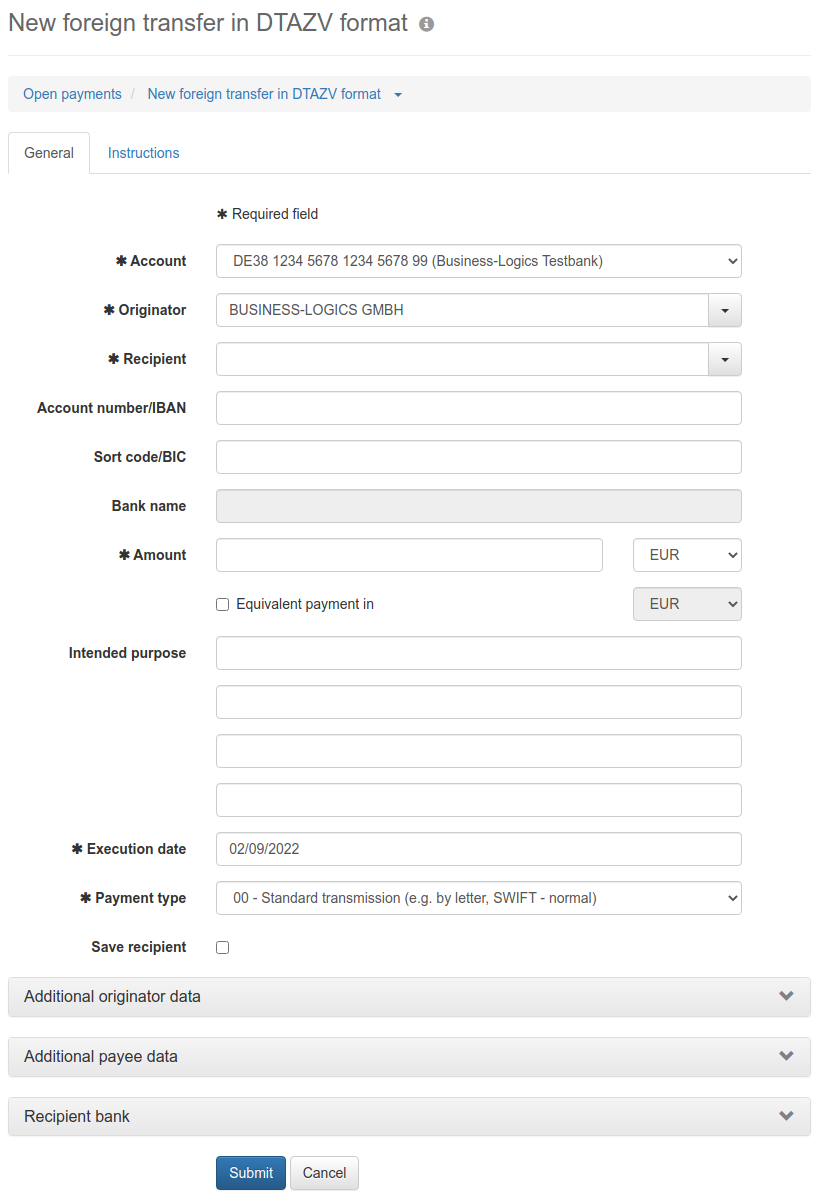
Figure: Form for entering a foreign transfer
A foreign transfer is the classic form of payment across national borders beyond Europe or for a payment in a foreign currency. The processing format is DTAZV.
Because of the large number of fields, this page is divided into expandable sections for the additional data of originator and payee, as well as a separate tab for the instructions. See the section Additional originator data and the following for this.
The data entry for these fields follows the description in the section SEPA transfer.
The IBAN is not mandatory for this payment if you are entering payments to countries that are not EU members. In this case, enter an account number here.
Please enter the BIC of the payee's bank here. This is the same as the SWIFT address. If you don't know the BIC, you can leave this field empty and instead enter name and address of the bank under Additional payee data. If you know a national number of the payee's bank instead of the BIC, enter this number here. By the same way you can also enter the German bank code for payments in foreign currency within Germany.
Enter the desired amount for the payment currency here. Then select the payment currency from the drop-down list to the right of the field. The corresponding value in EUR is automatically displayed, provided the average exchange for this currency is listed in the daily fixing of the European Central Bank (ECB). The rates are automatically updated once per day. This requires an Internet connection.
This checkbox is only active when EUR is selected as the currency to the right of the field. You can then issue an equivalent value payment, e.g. you enter an amount in Euros which the recipient receives in the currency that you selected from the drop-down list to the right of the field. Here as well, the equivalent value is shown below if available.
The ECB issues the ECB rates daily at 2:15 p.m. Before this time, only the previous day's rate is available.
The indicated rates are average rates and exclusively used to determine whether a Z1 report of the payment needs to the provided to the Bundesbank and to determine an approximate value for the debit charged to your current account. Trades are not performed at the average rate - the buy and sell rates deviate up or down from this.
You are generally charged the bid price when your payment orders are settled.
Since banks conduct their own currency trades, and can therefore also charge their own rates (which may deviate from the ECB rate), you should discuss the actually charged rate with your bank.
Here, you have four fields with up to 35 characters available to describe the purpose of the payment in greater detail.
Please note that you generally need to submit foreign currency payment orders to your bank two days before the execution date. The bank needs this advance notice to obtain the required currency on the currency market.
You can select from the following payment type as instructions for your bank:
Annotation for check payment: In this case, the check can either be sent to the beneficiary (20-23) of the payment, or to you as the originator (30-33). With the different sending methods, you can determine whether the letter is sent by standard mail, registered mail by courier, or courier only.

Figure: Form for entering a foreign transfer